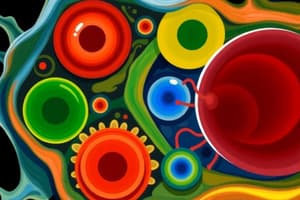Podcast
Questions and Answers
What are the building blocks of nucleic acids?
What are the building blocks of nucleic acids?
- Amino acids
- Monosaccharides
- Fatty acids
- Nucleotides (correct)
Which of the following types of molecules store energy more efficiently per gram than carbohydrates?
Which of the following types of molecules store energy more efficiently per gram than carbohydrates?
- Triglycerides (correct)
- Nucleic acids
- Simple sugars
- Proteins
What type of macromolecule is primarily made up of amino acids?
What type of macromolecule is primarily made up of amino acids?
- Nucleic acids
- Carbohydrates
- Lipids
- Proteins (correct)
Which of these is NOT a type of lipid?
Which of these is NOT a type of lipid?
What role do polysaccharides like glycogen play in living organisms?
What role do polysaccharides like glycogen play in living organisms?
Which component is NOT found in a nucleotide?
Which component is NOT found in a nucleotide?
What is the primary structure of a protein determined by?
What is the primary structure of a protein determined by?
Which of the following molecules is used as the energy currency of the cell?
Which of the following molecules is used as the energy currency of the cell?
What is the primary level of protein structure characterized by?
What is the primary level of protein structure characterized by?
What role does ATP play in biological systems?
What role does ATP play in biological systems?
Which of the following statements correctly defines nucleic acids?
Which of the following statements correctly defines nucleic acids?
What happens to proteins during denaturation?
What happens to proteins during denaturation?
What is the secondary structure of a protein primarily formed by?
What is the secondary structure of a protein primarily formed by?
Which of the following is NOT considered a key element in biology?
Which of the following is NOT considered a key element in biology?
Which of the following descriptions matches quaternary protein structure?
Which of the following descriptions matches quaternary protein structure?
What is one characteristic feature of colloids in biological systems?
What is one characteristic feature of colloids in biological systems?
What is the primary role of enzymes in metabolism?
What is the primary role of enzymes in metabolism?
Which statement accurately describes catabolism?
Which statement accurately describes catabolism?
Which structure level in proteins describes the sequence of amino acids?
Which structure level in proteins describes the sequence of amino acids?
What happens to proteins under extreme conditions such as high heat?
What happens to proteins under extreme conditions such as high heat?
Which of the following correctly describes ATP?
Which of the following correctly describes ATP?
What key role does RNA play in relation to DNA?
What key role does RNA play in relation to DNA?
What is the functional difference between synthesis and decomposition reactions?
What is the functional difference between synthesis and decomposition reactions?
Which level of protein structure involves multiple protein chains combining?
Which level of protein structure involves multiple protein chains combining?
Study Notes
ATP and Energy Transfer
- ATP (Adenosine Triphosphate) is the primary energy currency of cells, crucial for various cellular processes.
- Energy is stored in the high-energy bonds between ATP's phosphate groups; breaking these bonds releases energy.
Protein Structure
- Proteins are made of amino acids linked by peptide bonds, exhibiting multiple structural levels.
- Primary Structure: Sequence of amino acids.
- Secondary Structure: Formation of alpha helices or beta sheets through hydrogen bonds.
- Tertiary Structure: 3D folding resulting from interactions among R groups.
- Quaternary Structure: Multiple polypeptide chains combine to form functional proteins.
- Protein denaturation may occur due to extreme conditions like heat or pH changes, disrupting their structure and function.
Nucleic Acids: DNA and RNA
- DNA (Deoxyribonucleic Acid) carries genetic information essential for cell functions and heredity.
- RNA (Ribonucleic Acid) synthesizes proteins by interpreting DNA instructions.
Metabolism
- Metabolism encompasses all chemical reactions in the body, divided into catabolism (break down molecules) and anabolism (build larger molecules).
- Key metabolic reactions include:
- Decomposition: Breaking down molecules into smaller parts.
- Synthesis: Combining smaller molecules into larger compounds.
- Exchange: Swapping atoms or molecules between compounds.
Organic Molecules: Proteins, Carbohydrates, Fats
- Proteins provide structural support, transport, enzymatic activity, and signaling in biological systems.
- Monomers are the building blocks, combining to form polymers; for example, monosaccharides form polysaccharides like glycogen.
- Macromolecules include carbohydrates, fats (triglycerides), phospholipids, steroids, and eicosanoids, which serve as energy storage and structural components.
Trace Elements and Body Composition
- Key elements such as oxygen, carbon, hydrogen, nitrogen, calcium, and phosphorus make up 98.5% of body weight.
- Trace elements, although present in minute amounts, are vital for various physiological processes.
Ions and Colloids
- Ions are charged particles involved in chemical reactions and cellular functions.
- Colloids consist of larger particles that scatter light, typically made of a mixture of water and proteins.
Studying That Suits You
Use AI to generate personalized quizzes and flashcards to suit your learning preferences.
Related Documents
Description
This quiz focuses on the role of adenosine triphosphate (ATP) in determining protein shape and function, along with the effects of extreme conditions on protein denaturation. It also covers the composition of nucleic acids, specifically DNA and RNA, and their roles in genetic information. Test your knowledge about these essential biological concepts.



